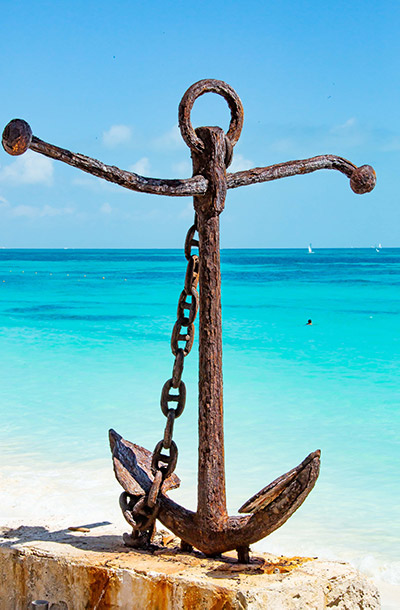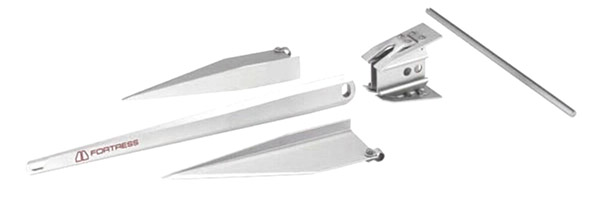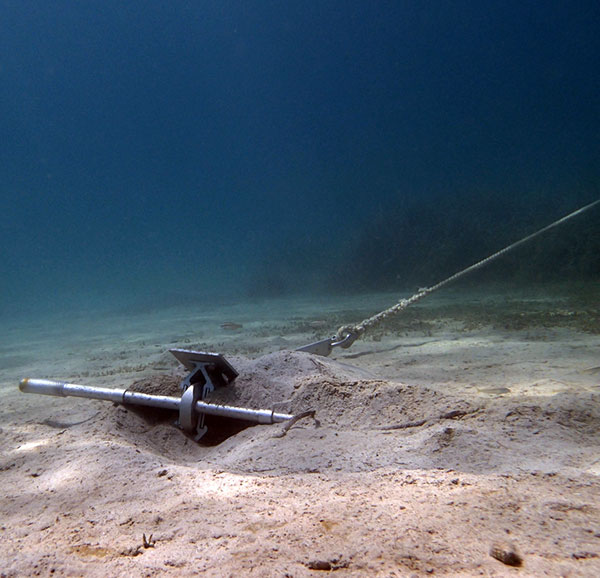Fortress, the ultimate lightweight aluminum anchor
Over the last few decades, new anchor types have been added to the traditional range of mooring equipment. In this new Product Test, we take a look at a more modern anchor. Meet the Fortress, a lightweight anodized aluminum anchor we’ve tested many times during our travels.

What’s the difference between a lightweight anchor and a primary anchor?
The reason it’s called a lightweight anchor is primarily because the main anchor is heavier. And since anchors are most often quoted in weight units (kilograms or pounds), it sound legitimate to wonder whether a light anchor is not a second-rate anchor. Could it perform more poorly? Thankfully, no. It weighs less primarily because its material, aluminum, is less dense than steel, stainless steel or lead. Thus, it weighs less, which is also an asset.
This fact doesn’t make a light anchor any smaller, though, for its surface area is just as large. It’s just less weighty. However, an anchor’s holding power in most seabeds is largely due to its surface area. So, under certain conditions, the lightweight anchor can compete with more conventional tackle equipment.
The Fortress, a variation on flat anchors
Anchors have evolved over the ages, starting with simple stone weights. Sailors then perfected their anchors, moving from rusting iron to steel. Aluminum is a relative newcomer. Ultra-resistant versions only made it to the market at the end of the 20th century. This is how the Fortress anchor came into being around 1990.
Until then, the models available to yachtsmen had hardly changed in 50 years. For the most part, they were simply based off of models used on larger boats. Until the 2000s, the recreational boating market was dominated by plow-shaped anchors (CQR and its variants) and flat anchors (mainly FOB, Britany, Danforth).
Anodized aluminum construction, rather than simply replicating the shapes, also enabled us to adapt the design. With this lighter but equally resistant material, Fortress has taken flat anchor design to a new level. After all, this lightweight anchor can be laid flat and stored more easily.
Parts of the Fortress lightweight anchor
The Fortress anchor naturally features a fairly long, sturdy solid aluminum shank. At the crown, i.e. opposite to where the anchor line is fastened, two swivelling flukes are found. They are conspicuous for their ample surface area and tapered ends. The stock, a long rod that allows the anchor to be correctly positioned on the bottom, acts as a hinge and locks the entire assembly.

In the crown, the stock can take one of two positions: one standard and the other suitable for very soft bottoms. This second option opens the fluke angle from 32° to 45°. This increases the surface area of resistance. Note that this is only recommended for very soft bottoms. Using this option on other types of seabeds could damage the flukes. Indeed, according to the manufacturer’s data, this doubles tensile strength! Finally, “mud palms” are attached to the crown to provide extra lift in very soft mud.
The Fortress disassembles easily for compact storage
A final interesting feature of the Fortress is that the anchor can be completely disassembled. On the one hand, this makes for easier stowage and maintenance. It also gives the Fortress anchor another advantage. It doesn’t depend on welds that could fail without warning. Two bolts do, of course, lock the assembly together, but they are not where the stress lies when at anchor.

What types of bottom can the Fortress be used on?
Let’s first point out that every anchor family and model has its own strengths and weaknesses. The Fortress is no exception. The key, therefore, is for the sailor to be familiar with the ground tackle gear, and to use it in the right conditions.
On sand, shells, gravel or mud, the Fortress anchor generally works very well. As we’ve seen, the Fortress even has a configuration for anchoring in very soft mud. However, unless you sail all the time in soft mud areas, you’ll need to constantly dismantle and reassemble the anchor to change the fluke angle.
Some seabeds are particularly tough, though, whatever the type of anchor. In these cases, the Fortress is no magic solution. In very, very compact and hard sand, the anchor will naturally have trouble digging in. Because of its large surface area, it will also have difficulty penetrating seaweed and some sea grass. Finally, in particularly rocky bottoms, the anchor will grip, but it can easily snag. Freeing it without bending the flukes or straining the windlass could be complicated.
When and how to use a lightweight anchor?

Now we know where to use the Fortress, we just need to know in which situations. As with other flat anchors, the Fortress will provide good holding power in he direction of the shank. However, if the traction changes direction after the anchor is set, this may cause the anchor to unset. In bottoms other than dense mud or loose sand, it may have trouble re-setting.
The ideal anchor for a lunch anchor stop
This means the Fortress is particularly suitable for temporary daytime anchorages, as long as you keep an eye on the boat. When stopping for lunch or at a beach, for example, bearing in mind that if wind or current change, you’ll probably need to re-anchor or at a minimum strengthen your watch crew. In any case, ensuring the anchor is set is done as with any anchor. Make sure that the anchor has securely dug in by reversing the engine for several tens of seconds, gradually increasing the power.
The preferred anchor for a second mooring
The Fortress is also very suitable as a second anchor. If you’re going to anchor bow and stern for example, it will make a good kedge anchor. To a lesser extent, it could also be suitable when needing to moor Bahamian style, when setting up a tandem-anchor rig or a forked moor.
The benefit of this lightweight anchor is just that… it’s light! And as such, it’s easy to anchor from the stern if required, since it’s easy to handle by hand. But above all, it’s particularly suited to anchoring with a dinghy. Hauling an anchor in a second direction, whether from the bow or the stern, and even taking a line ashore if there’s no tree or fixed point within easy reach: all this can easily be done in a dinghy with a Fortress!
Finally, the Fortress is particularly well-suited to multihulls. On a catamaran or trimaran, where weight distribution is all the more crucial, it’s more likely to be used as the regular go-to anchor. Of course, you’ll then need to keep another more all-around anchor in the bilge for situations requiring more tackle versatility.
Best practices with a Fortress lightweight anchor

On the other hand, it is not advisable to rely on a Fortress alone if you are anchoring for the night. The same applies in unsettled weather, or if you’re anchoring in an area with tidal currents. To do so would be to expose yourself to the boat and rode direction shifting, the consequences of which would probably be unpleasant or dangerous!
(As an aside: by the way, do you have the right wind indicator to know where the wind is blowing from?)
Which rode to use with the Fortress?
Then there’s the question of which anchor line to use on a Fortress. If you have to handle the anchor on the stern or transom of a boat, or worse still in a dinghy, an all-chain mooring line with a lightweight anchor is obviously not the way to go.
However, unless you’re going to take the Fortress ashore, an all-rope line will be far less effective. It will be more likely to dislodge the anchor. As with any type of anchor, it’s best to pull on the shank as horizontally as possible. This means a bit more weight at the beginning of the anchor line is a big plus. Think about using a leaded line, or adding a small chunk of chain before switching to rope.
One final tip: Fortress anchors often hold so well, and will dig in so firmly, that they may be difficult to dislodge. If the anchorage area allows it, it may be worth attaching a tripping line to the anchor’s crown. This will make it easier for you to raise the anchor. In some cases it has taken us 45 minutes to free the kedge anchor: far longer than the bower anchor!
The different Fortress anchor models
The Fortress anchor is available in 9 different sizes, to suit your boat’s dimensions. From the FX-7, weighing less than 2 kg (4 lbs) and suitable for boats from 5 to 8 m (16-27 ft), to the 31 kg (69 lbs) FX-125 mastodon for yachts over 27 m (90 ft), the range also includes all intermediate sizes: FX-11, FX-16, FX-23, FX-37, FX-35, FX-85 and FX-115.
If you’re wondering about the naming scheme, there’s actually a trick: the number actually corresponds to the weight in pounds of an equivalent steel anchor. The easiest way to select a model is to use the manufacturer’s own selection matrix.
Depending on your sailing plans, it may be advisable to oversize your Fortress anchor in relation to the manufacturer’s recommendations. The manufacturer points this out, stating that recommendation based on boat length alone corresponds to standard use. Above 30 knots of wind, it’s better to use an anchor one or even two sizes larger.
That’s what we did, using the FX-23 model for a 36-foot monohull. Our Fortress anchor held without flinching in squalls exceeding 45 knots! And yet the gusts were mostly blowing off the beam, inducing additional strain.
Maintenance and storage of your Fortress lightweight anchor
A Fortress anchor requires very little maintenance. Obviously, you’ll need to clean it as well as possible after you’ve retrieved it, especially if it’s bringing up sticky mud. A fresh-water rinse, if possible, obviously doesn’t hurt.

Finally, pay attention to the storage location. Aluminum, even when anodized, doesn’t like to come into contact with other metals (such as steel or stainless steel). This is especially true if salt water often comes in between the two metals. So be careful to avoid contact with your galvanized chain or other anchors.
If your Fortress fits in the anchor locker, be sure to keep a layer of some kind between any metal element and your Fortress. A piece of wood or padding will do, but no plastic wrapping. Water must be able to drain and dry!
A lightweight anchor is handy to have around
Your Fortress can also be stored elsewhere than in the anchor locker. Railing mounts are available to store your aluminum anchor safely and within easy reach for aft mooring. We’ve equipped ourselves in this way, and we must admit it’s very practical.
Failing that, others have built their own homemade brackets, the main consideration here being ease of use. If the Fortress is stored flat on deck or on the bow roller, chocks can also be found or created. This prevents the anchor tips from scraping or banging against the hull or deck.
We now wish you safe sailing with your lightweight anchor. Your boat (and your back!) will thank you. See you soon for more Product Reviews.
Note: we are in no way connected or affiliated with the Fortress Anchors company, which manufactures the Fortress lightweight anchors. This product test reflects our own experience after purchasing and using this equipment on our boat. Pictures are the property of their respective owners.
